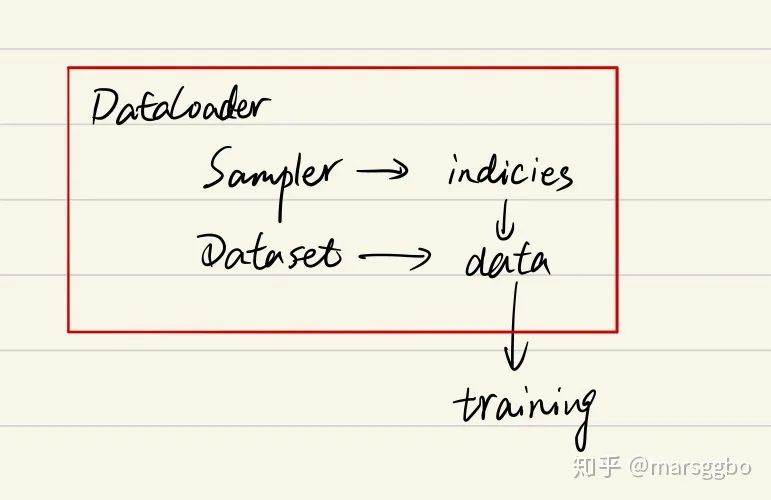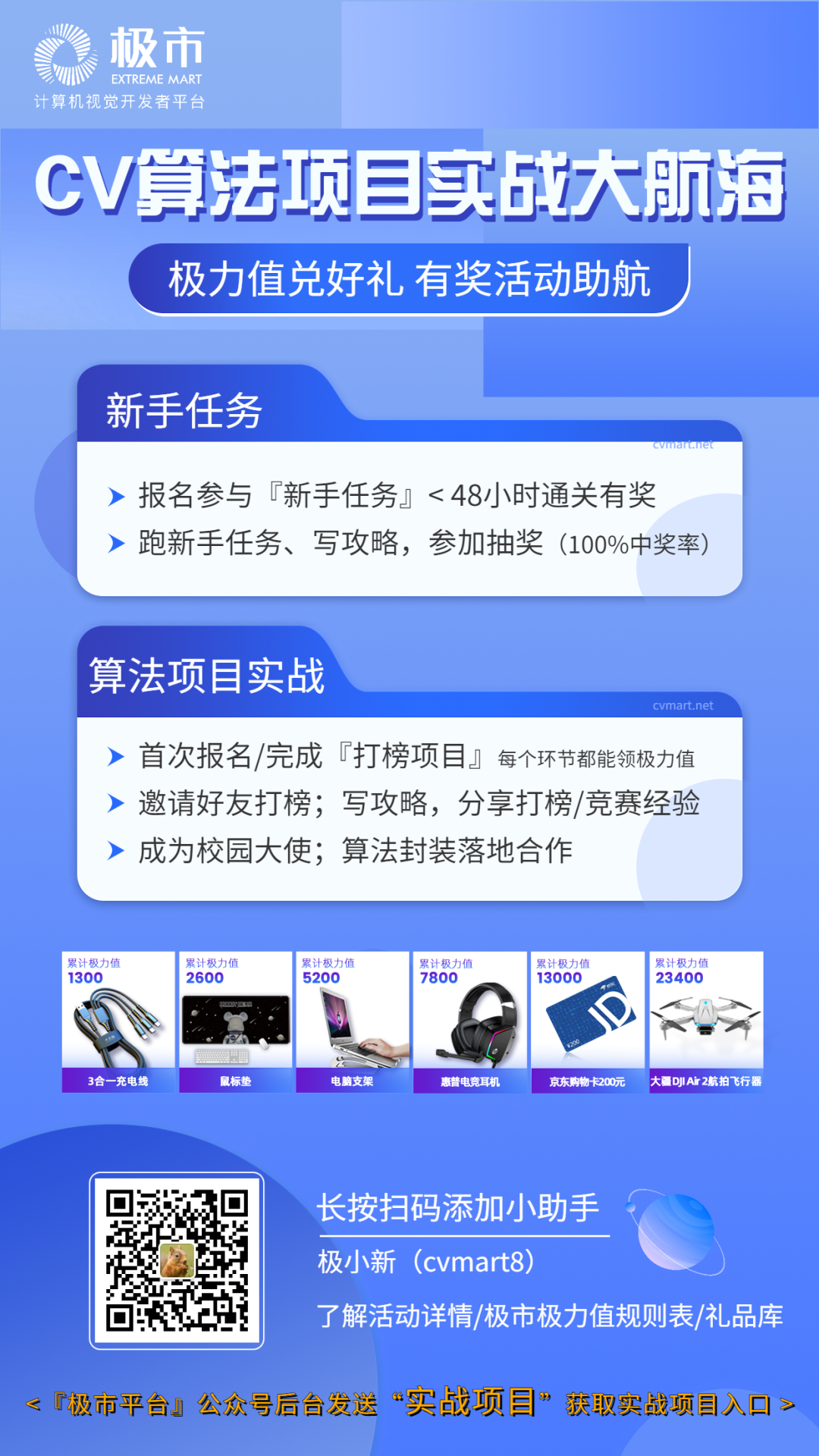一文弄懂Pytorch的DataLoader, DataSet, Sampler之间的关系

极市导读
很多文章都是从Dataset等对象自下往上进行介绍,但是对于初学者而言,其实这并不好理解,因为有的时候会不自觉地陷入到一些细枝末节中去,而不能把握重点,所以本文将会自上而下地对Pytorch数据读取方法进行介绍。 >>加入极市CV技术交流群,走在计算机视觉的最前沿
以下内容都是针对Pytorch 1.0-1.1介绍。
自上而下理解三者关系
首先我们看一下DataLoader.__next__的源代码长什么样(代码链接:https://github.com/pytorch/pytorch/blob/0b868b19063645afed59d6d49aff1e43d1665b88/torch/utils/data/dataloader.py#L557-L563)。
为方便理解我只选取了num_works为0的情况(num_works简单理解就是能够并行化地读取数据)。
class DataLoader(object):
...
def __next__(self):
if self.num_workers == 0:
indices = next(self.sample_iter) # Sampler
batch = self.collate_fn([self.dataset[i] for i in indices]) # Dataset
if self.pin_memory:
batch = _utils.pin_memory.pin_memory_batch(batch)
return batch
在阅读上面代码前,我们可以假设我们的数据是一组图像,每一张图像对应一个index,那么如果我们要读取数据就只需要对应的index即可,即上面代码中的indices,而选取index的方式有多种,有按顺序的,也有乱序的,所以这个工作需要Sampler完成,现在你不需要具体的细节,后面会介绍,你只需要知道DataLoader和Sampler在这里产生关系。
那么Dataset和DataLoader在什么时候产生关系呢?没错就是下面一行。我们已经拿到了indices,那么下一步我们只需要根据index对数据进行读取即可了。
再下面的if语句的作用简单理解就是,如果pin_memory=True,那么Pytorch会采取一系列操作把数据拷贝到GPU,总之就是为了加速。
综上可以知道DataLoader,Sampler和Dataset三者关系如下:

在阅读后文的过程中,你始终需要将上面的关系记在心里,这样能帮助你更好地理解。
Sampler
参数传递
要更加细致地理解Sampler原理,我们需要先阅读一下DataLoader 的源代码,如下:
class DataLoader(object):
def __init__(self, dataset, batch_size=1, shuffle=False, sampler=None,
batch_sampler=None, num_workers=0, collate_fn=default_collate,
pin_memory=False, drop_last=False, timeout=0,
worker_init_fn=None)
可以看到初始化参数里有两种sampler:sampler和batch_sampler,都默认为None。前者的作用是生成一系列的index,而batch_sampler则是将sampler生成的indices打包分组,得到一个又一个batch的index。例如下面示例中,BatchSampler将SequentialSampler生成的index按照指定的batch size分组。
>>>in : list(BatchSampler(SequentialSampler(range(10)), batch_size=3, drop_last=False))
>>>out: [[0, 1, 2], [3, 4, 5], [6, 7, 8], [9]]
Pytorch中已经实现的Sampler有如下几种:
-
SequentialSampler -
RandomSampler -
WeightedSampler -
SubsetRandomSampler
需要注意的是DataLoader的部分初始化参数之间存在互斥关系,这个你可以通过阅读源码更深地理解(https://github.com/pytorch/pytorch/blob/0b868b19063645afed59d6d49aff1e43d1665b88/torch/utils/data/dataloader.py#L157-L182)。这里只做总结:
-
如果你自定义了batch_sampler,那么这些参数都必须使用默认值:batch_size, shuffle,sampler,drop_last.
-
如果你自定义了sampler,那么shuffle需要设置为False
-
如果sampler和batch_sampler都为None,那么batch_sampler使用Pytorch已经实现好的BatchSampler,而sampler分两种情况:
-
若shuffle=True,则sampler=RandomSampler(dataset) -
若shuffle=False,则sampler=SequentialSampler(dataset)
如何自定义Sampler和BatchSampler?
class Sampler(object):
r"""Base class for all Samplers.
Every Sampler subclass has to provide an :meth:`__iter__` method, providing a
way to iterate over indices of dataset elements, and a :meth:`__len__` method
that returns the length of the returned iterators.
.. note:: The :meth:`__len__` method isn't strictly required by
:class:`~torch.utils.data.DataLoader`, but is expected in any
calculation involving the length of a :class:`~torch.utils.data.DataLoader`.
"""
def __init__(self, data_source):
pass
def __iter__(self):
raise NotImplementedError
def __len__(self):
return len(self.data_source)
Dataset
class Dataset(object):
def __init__(self):
...
def __getitem__(self, index):
return ...
def __len__(self):
return ...
class DataLoader(object):
...
def __next__(self):
if self.num_workers ==
0:
indices = next(self.sample_iter)
batch = self.collate_fn([self.dataset[i]
for i
in indices])
# this line
if self.pin_memory:
batch = _utils.pin_memory.pin_memory_batch(batch)
return batch
-
indices: 表示每一个iteration,sampler返回的indices,即一个batch size大小的索引列表 -
self.dataset[i]: 前面已经介绍了,这里就是对第i个数据进行读取操作,一般来说self.dataset[i]=(img, label)
公众号后台回复“ECCV2022”获取论文分类资源下载~
“
点击阅读原文进入CV社区
收获更多技术干货


